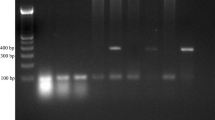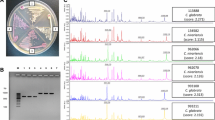Abstract
Nineteen clinical isolates ofCandida albicans andC. dubliniensis were isolated from patients (majority of them HIV-positive) in Slovakia, Brazil, Thailand and Japan. Species discrimination was performed by using growth on CHROMagar Candida, commercial biochemical set API 20C AUX, germ-tube test in human serum, growth at 42 and 45°C on Sabouraud-dextrose agar as well as on CHROMagar Candida, assimilation ofd-xylose and methyl α-d-glucoside by glass-tube test, and production of chlamydospores. These tests were completed by PCR using Cd-oligo2/F and Cd-oligo2/R primer pair specific forC. dubliniensis. Six clinical isolates were confirmed to beC. dubliniensis, remaining 13 strains were determined asC. albicans. The use of conventional method showed that the determination is markedly influenced by personal evaluation suggesting the necessity of using the combination of many tests to obtain correct results comparing with accurate and rapid PCR assay. For discrimination betweenC. albicans andC. dubliniensis we recommend the combination of primo-cultivation on CHROMagar, followed by germ-tube test and PCR.
Similar content being viewed by others
References
Baumgartner C., Freydiere A.M., Gille Y.: Direct identification and recognition of yeast species from clinical material by using Albicans ID and CHROMagar Candida plates.J.Clin.Microbiol. 34, 454–456 (1996).
Bautista-Muñoz C., Boldo X.M., Villa-Tanaca L., Hernández-Rodrígez C.: Identification ofCandida spp. by randomly amplified polymorphic DNA analysis and the differentiation betweenCandida albicans andCandida dubliniensis by direct PCR methods.J.Clin.Microbiol. 41, 414–420 (2003).
Cardenes C.D., Carrillo A.J., Arias A., Rodriguez-Alvarez C., Torres-Lana A., Sierra A., Arevalo M.P.: Comparison ofAlbicans ID2 agar plate with the germ tube for presumptive identification ofC. albicans.Diagn.Microbiol.Infect.Dis. 42, 181–185 (2002).
Coleman D.C., Sullivan D.J., Bennett D.E., Moran G.P., Barry H.J., Shanley D.B.: Candidiasis: the emergence of a novel species,Candida dubliniensis.AIDS 11, 557–567 (1997).
Cooke V.M., Miles R.J., Price R.G., Midgley G., Khamri W., Richardson A.C.: New chromogenic agar medium for the identification ofCandida spp.Appl.Environ.Microbiol. 68, 3622–3627 (2002).
De Hoog G.S., Guarro J., Gene J., Figurras M.J.:Altas of Clinical Fungi, 2nd ed. American Society for Microbiology, Hardcover (USA) 2001.
Dorko E., Virágová S., Jautová J., Pilipčinec E., Danko J., Švický E., Tkáčiková L’.: Electrophoretic karyotyping ofCandida albicans strains isolated from premature infants and hospital personnel in a neonatal intensive care unit.Folia Microbiol. 46, 453–457 (2001).
Dorko E., Viragová S., Pilipčinec E., Danko J., Tkačiková L’.:Candida species isolated from cerebrospinal fluid.Folia Microbiol. 47, 179–181 (2002).
Fotedar R., Al Hedaithy S.S.:Candida dubliniensis at a University Hospital in Saudi Arabia.J.Clin.Microbiol. 41, 1907–1911 (2003).
Gales A.C., Pfaller M.A., Houston A.K., Joly S., Sullivan D.J., Coleman D.C., Soll D.R.: Identification ofCandida dubliniensis based on temperature and utilization of xylose and α-methyl-d-glucoside as determined with the API 20C AUX and Vitek YBC Systems.J.Clin.Microbiol. 37, 3804–3808 (1999).
Giammanco G.M., Pignato S., Salvo S., Giammanco G.: Carbohydrate assimilation profiles of the first ItalianCandida dubliniensis clinical isolates recovered from an HIV-infected individuals.Res.Mirobiol. 151, 889–891 (2000).
Giammanco G.M., Pizzo G., Pecorella S., Distefano S., Pecoraro V., Milici M.E.: Identification ofCandida dubliniensis among oral yeast isolates from an Italian population of human immunodeficiency virus-infected (HIV+) subjects.Oral Microbiol. Immunol. 17, 89–94 (2002).
Hong S.G., Bae K.S., Herzberg M., Titze A., Lachance M.A.:Candida kunwiensissp.nov., an yeast associated with flowers and bumblebees.Internat.J.Syst.Evol.Microbiol. 53, 367–372 (2003).
Jabra-Rizk M.A., Falkler W.A. Jr.,Merz W.G., Baqui A.A.M.A., Kelley J.I., Meiller T.F.: Retrospective identification and characterization ofCandida dubliniensis isolates amongCandida albicans clinical laboratory isolates from human immunodeficiency virus (HIV)-infected and non-HIV-infected individuals.J.Clin.Microbiol. 38, 2423–2426 (2000).
Jabra-Rizk M.A., Brenner T.M., Romagnoli M., Baqui A.A.M.A., Merz W.G., Falkler W.A., Meiller T.M.: Evaluation of a reformulated CHROMagar Candida.J.Clin.Microbiol. 39, 2015–2016 (2001).
Kirkpatrick W.R., Revankar S.G., McAtee R.K., Lopez-Ribot J.L., Fothergill A.W., McCarthy D.I., Sanche S.E., Cantu R.A., Rinaldi M.G., Patterson T.F.: Detection ofCandida dubliniensis in oropharyngeal samples from human immunodeficiency virus-infected patients in North America by primary CHROMagar Candida screening and susceptibility testing of isolates.J.Clin.Microbiol. 36, 3007–3012 (1998).
Korabečna M., Liška V., Fajfrlik K.: Primers ITS1, ITS2 and ITS4 detect the intraspecies variability in the internal transcribed spacers and 5.8S rRNA gene region in clinical isolates of fungi.Folia Microbiol. 48, 233–238 (2003).
Kurzai O., Heinz W.J., Sullivan J.D., Coleman D.C., Frosch M., Muhlschlegel F.A.: Rapid PCR test for discriminating betweenCandida albicans andCandida dubliniensis isolates using primers derived from the pH-regulatedPHR1 andPHR2 genes ofC. albicans.J.Clin.Microbiol. 37, 1587–1590 (1999).
Kurzai O., Kortig H.C., Harmsen D., Bautsch W., Molitor M., Frosch M., Muhlschlegel F.A.: Molecular and phenotypic identification of the yeast pathogenCandida dubliniensis.J.Mol.Med. 78, 521–529 (2000).
Larone D.H.:Medically Important Fungi. A Guide to Identification, 3rd ed. ASM Press, Washington (DC) 1995.
Martinez M., López-Ribot J.L., Kirkpatrick W.R., Coco B.J., Bachmann S.P., Patterson T.F.: Replacement ofCandida albicans withCandida dubliniensis in human immunodeficiency virus-infected patients with oropharyngeal candidiasis treated with fluconazole.J.Clin.Microbiol. 40, 3135–3139 (2002).
Odds F.C., Bernaerts R.: CHROMagar Candida, a new differential isolation medium for presumptive identification of clinically importantCandida species.J.Clin.Microbiol. 32, 1923–1929 (1994).
Olver W.J., Stafford J., Cheetham P., Boswell T.C.: Comparison of Candida ID medium with Sabouraud-chloramphenicol agar for the isolation of yeasts from clinical haematology surveillance specimens.J.Med.Microbiol. 51, 221–224 (2002).
Park S., Wong M., Marras S.A.E., Cross E.W., Kiehn T.E., Chaturvedi V., Tyagi S., Perlin D.S.: Rapid identification ofCandida dubliniensis using a species-specific molecular beacon.J.Clin.Microbiol. 38, 2829–2836 (2000).
Perea S., López-Ribot J.L., Wickes B.L., Kirkpatrick W.R., Dib O.P., Bachmann S.P., Keller S.M., Martinez M., Patterson T.F.: Molecular mechanisms of fluconazole resistance inCandida dubliniensis isolates from human immunodeficiency virus-infected patients with oropharyngeal candidiasis.Antimicrob.Agents Chemother. 46, 1695–1703 (2002).
Pincus D.H., Coleman D.C., Pruitt W.R., Padhye A.A., Salkin I.F., Geimer M., Bassel A., Sullivan D.J., Clarke M., Hearn V.: Rapid identification ofCandida dubliniensis with commercial yeast identification system.J.Clin.Microbiol. 37, 3533–3539 (1999).
Pinjon E., Sullivan D., Salkin I., Shanley D., Coleman D.: Simple, inexpensive, reliable method for differentiation ofCandida dubliniensis fromCandida albicans.J.Clin.Microbiol. 36, 2093–2095 (1998).
Ruhnke M., Schmidt-Westhausen A., Morschhauser J.: Development of simultaneous resistance to fluconazole inCandida aibtcans andCandida dubliniensis in a patient with AIDS.J.Antimicrob.Chemother. 46, 291–295 (2000).
Sancak B., Rex J.H., Paetznick V., Chen E., Rodriguez J.: Evaluation of a method for identification ofCandida dubliniensis blood-stream isolates.J.Clin.Microbiol. 41, 489–491 (2003).
Schoofs A., Odds F.C., Colebunders R., Ieven M., Goossens H.: Use of specialized isolation media for recognition and identification ofCandida dubliniensis isolates from HIV-infected patients.Eur.J.Clin.Microbiol.Infect.Dis. 16, 296–300 (1997).
Sullivan D.J., Coleman D.C.:Candida dubliniensis: characteristics and identification.J.Clin.Microbiol. 36, 329–334 (1998).
Sullivan D.J., Westerneng T.J., Haynes K.A., Bennett D.E., Coleman D.C.:Candida dubliniensis sp.nov.: phenotypic and molecular characterization of novel species associated with oral candidosis in HIV-infected individuals.Microbiology 141, 1507–1521 (1995).
Watanabe K., Katsu M., Mekha N., Poonwan N., Ando A., Mikami Y.: Preparation of a new specific PCR primer for the identification ofCandida dubliniensis isolates from clinical and environmental sources.Rep.Environ.Res.Organiz.Chiba Univ. 27, 15–19 (2001).
Wirsching S., Moran G.P., Sullivan D.J., Coleman D.C., Morschhäuser J.: MDR1-mediated drug resistance inCandida dubliniensis.Antimicrob.Agents Chemother. 45, 3416–3421 (2001).
Author information
Authors and Affiliations
Corresponding author
Additional information
This research was supported by organizationJSPS Invitation Fellowship for Researcher in Japan (no. S02296), grant no. 1/0020/03 from theSlovak Research Grant Agency, Slovakia, grant APVT-20-01590,Frontier Studies and International Networking of Genetic Resources in Pathogenic Fungi and Actinomycetes through theSpecial Coordination Founds for Promoting Science and Technology from theMinistry of Education, Culture, Sports, Science and Technology of Japan, andGrant-in-Aid for Scientific Research from theMinistry of Education, Culture and Sports, Science and Technology of Japan (no. 14570231) (both to the last author).
Rights and permissions
About this article
Cite this article
Bujdáková, H., Melkusová, S., Soji, I. et al. Discrimination betweenCandida albicans andCandida dubliniensis isolated from HIV-positive patients by using commercial method in comparison with PCR assay. Folia Microbiol 49, 484–490 (2004). https://doi.org/10.1007/BF02931613
Received:
Revised:
Published:
Issue Date:
DOI: https://doi.org/10.1007/BF02931613




